

Toutes les tailles. School Emergency Plans. Like individuals and families, schools, daycare providers, workplaces, neighborhoods and apartment buildings should all have site-specific emergency plans.
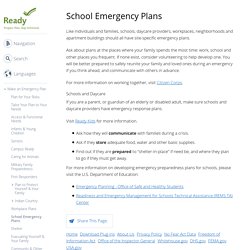
Ask about plans at the places where your family spends the most time: work, school and other places you frequent. If none exist, consider volunteering to help develop one. You will be better prepared to safely reunite your family and loved ones during an emergency if you think ahead, and communicate with others in advance. For more information on working together, visit Citizen Corps. Schools and Daycare If you are a parent, or guardian of an elderly or disabled adult, make sure schools and daycare providers have emergency response plans.
Visit Ready Kids for more information. Ask how they will communicate with families during a crisis.Ask if they store adequate food, water and other basic supplies.Find out if they are prepared to "shelter-in-place" if need be, and where they plan to go if they must get away. School Emergency Response Plan & Management Guide. Skip to main content School Emergency Response Plan & Management Guide In a natural or manmade disaster, or under elevated national security threat levels, events occur that necessitate the coordination and delivery of crisis intervention and response services.
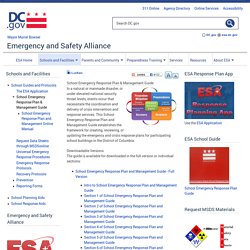
This School Emergency Response Plan and Management Guide establishes the framework for creating, reviewing, or updating the emergency and crisis response plans for participating school buildings in the District of Columbia. Downloadable Versions The guide is available for downloaded in the full version or individual sections: Online Manual The online manual version provides an overview by section: Twitter Facebook Mobile Maps Webcasts. Preparing Your School for a Cardiac Arrest Emergency. Representatives of the American Heart Association's Cardiac Emergency Response Plan Task Force, chaired by Comilla Sasson, MD, PhD, FACEP [1] presented "Preparing Your School for a Cardiac Arrest Emergency," in December during the Citizen CPR Foundation's Emergency Cardiovascular Care Update in San Diego.

Faculty included Michele Snyder and Martha Lopez-Anderson, Parent Heart Watch; Jeff Ranous, PhD, ATC, NREMT, American Heart Association; school nurse, Kathleen Murphy, DNP, RN, FNP-BC; and Mary Newman, MS, Sudden Cardiac Arrest Foundation. The session addressed the development of a comprehensive approach to effectively respond to cardiac emergencies in schools. Topics included an overview of the legislative landscape, overcoming obstacles, case studies, and emergency planning.
Newman presented the Cardiac Emergency Response Plan for Schools on behalf of the Task Force. A summary of her presentation follows. CPR In Schools. Object moved. Each year, more than 250,000 Americans die from sudden cardiac arrest.
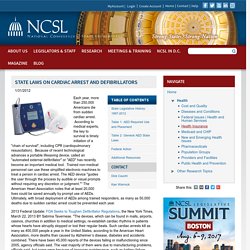
According to medical experts, the key to survival is timely initiation of a "chain of survival", including CPR (cardiopulmonary resuscitation). Because of recent technological advances a portable lifesaving device, called an "automated external defibrillator" or "AED" has recently become an important medical tool. Trained non-medical personnel can use these simplified electronic machines to treat a person in cardiac arrest. The AED device "guides the user through the process by audible or visual prompts without requiring any discretion or judgment. "1 The American Heart Association notes that at least 20,000 lives could be saved annually by prompt use of AEDs.
Ultimately, with broad deployment of AEDs among trained responders, as many as 50,000 deaths due to sudden cardiac arrest could be prevented each year. State Legislators have become actively involved with this issue in the past six years. Congress Acts on AEDs. How Well Does CPR Really Work? Dr.
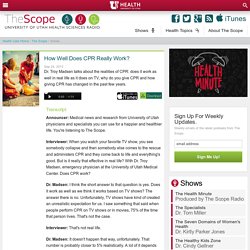
Troy Madsen talks about the realities of CPR: does it work as well in real life as it does on TV, why do you give CPR and how giving CPR has changed in the past few years. Transcript Announcer: Medical news and research from University of Utah physicians and specialists you can use for a happier and healthier life. You're listening to The Scope.
CPR Facts and Stats. CPR & AED Training. First Aid, CPR and AED Part 1. First Aid, CPR and AED Part 2. HeartSine 300P PAD How To Use. Heart Attack or Stroke? Call 911 First. And Fast. Many people in Washington die or are disabled from heart attack, cardiac arrest, and stroke because they do not get lifesaving treatment in time.
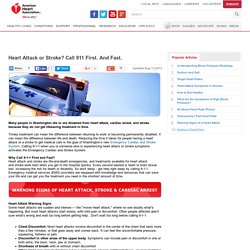
Timely treatment can mean the difference between returning to work or becoming permanently disabled. It can mean the difference between life and death. Reducing the time it takes for people having a heart attack or a stroke to get medical care is the goal of Washington’s new Emergency Cardiac and Stroke System. Calling 9-1-1 when you or someone else is experiencing heart attack or stroke symptoms activates the Emergency Cardiac and Stroke System. Why Call 9-1-1 First and Fast? Heart attack and stroke are life-and-death emergencies, and treatments available for heart attack and stroke work best when you get to the hospital quickly. Heart Attack Warning SignsSome heart attacks are sudden and intense — the "movie heart attack," where no one doubts what's happening.
Chest Discomfort. Cardiac Arrest Warning Signs Sudden loss of responsiveness.